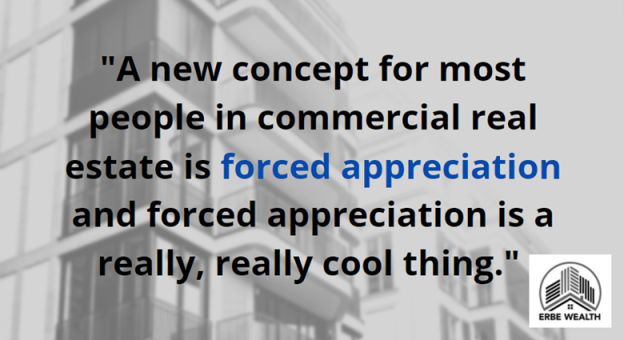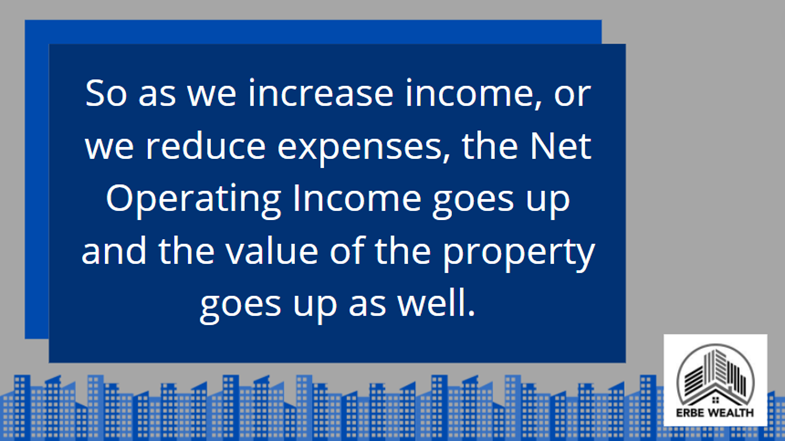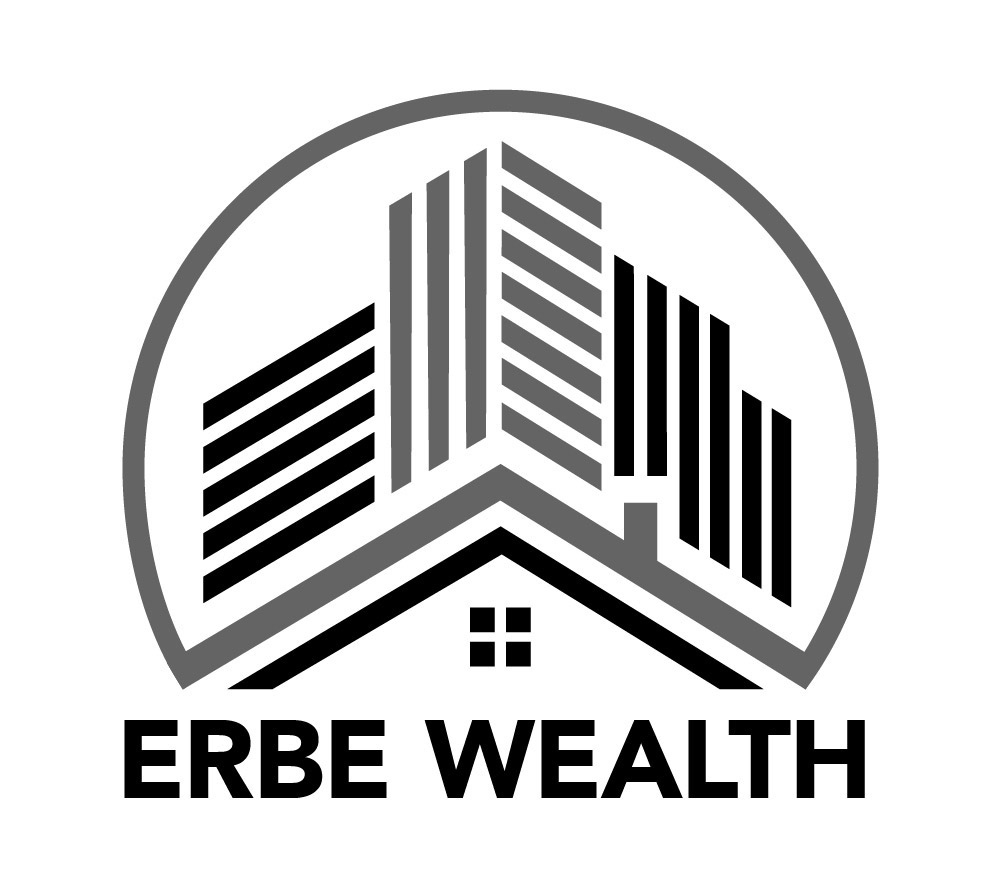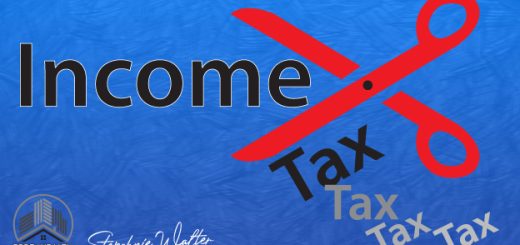What is Real Estate Appreciation
by Erbe Wealth · Published · Updated
What is real estate appreciation?
That’s when a house or an investment property increases over time.
What is Natural Versus Forced Depreciation?
Well, most of us think of our own single-family home or our own single-family rental, increasing in value over time has to a lot to do with the area it’s in and specifically what other houses that are like our house in our area are selling for at any given time.
There is a big difference of appreciation in multifamily real estate. The value of a multifamily real estate property is determined by the income, the net income that the property provides. So, I tell people to think of its kind of like a business in that you take the gross expenses of running the property and you minus those from the income and you get what’s called the net operating income and that is what determines the value of a property.
There are two different types of appreciation in multi-family properties most people are familiar with natural appreciation, which just means that you purchased in an area where there was growth and development and there was really a demand. And that’s what increases the single-family home’s value over time. But the value of a single-family rental is determined by what other properties that are similar in size and features have sold for in the immediate area.
How Value is Determined
The way value is determined in commercial multifamily is different than single family residential but we still are very concerned with finding a property in a good area. We look at purchasing a property in an area that is growing its population and that has a lot of projected job growth. A new concept for most people in commercial real estate is forced appreciation and forced appreciation is a really, really cool thing. It is how it sounds. We are able to force the appreciation of the property that we purchase.
So, we’re purposely out there looking for properties where the prior owner of the property has not taken advantage of a lot of different things that we can do to increase the value of the property.

The first thing that comes to mind is market rents. There are a ton of landlords that are not up to date with what the market is saying the rent should be. So, by merely increasing the rents up to market, that can be a huge, huge increase in the value of the property. But we go quite a few steps further than that. We look at different fees that we can be charging. We’re very familiar with the areas in which we purchase the real estate.
We look at who is our competition out there and what are they charging for? The most common fees are the following: pet fees, storage fees, trash valet services, parking fees, covered parking fees. All of those fees are ways in which we can increase the revenue of the property.
We can also increase the revenue of the property by just running the property much more efficiently than how it was run before. And we can do that because we have a great deal of experience of knowing, the most efficient ways to operate this multifamily property, which is essentially a business.
What is Important about Where We Invest?
Well, for us, as I mentioned before, it’s critically important that we find areas of the country that are growing in population also to have an enormous, projected economic growth, which these are all things that we do research on pretty heavily to determine what direction this town is going. Is it growing and expanding or is it contracting?
We are always looking for emerging markets, markets that were small and now people are flooding to them. That almost always leads to a shortage in housing, which is which is great for us. But another thing that we look for when we’re looking at areas in which to invest are landlord and business friendly states, and I think everybody can understand the importance of that.
We invest largely in the southeastern United States, largely in Florida, where they have a very pro-growth pro-business mindset to the way that they run their state. And that’s very important to us.
What Types of Multifamily Property do We Look to Buy?
There are actually four distinct categories of multifamily assets. There’s a type A. I tell people to think of that’s like your luxury apartment in your downtown area that has the valet parking, the doorman, the swimming pool, the bar and all of these great things, a gym inside, just a very high-end luxury type of property.
Then there is a B type property. It is a little bit older. Usually, we look more into the suburbs for this type. It’s still a very nice property. It just doesn’t have all the bells and whistles that an A type property has. It’s usually a very good area, very good school district, so it really attracts people, with good stable jobs to be living there.
The next class is C properties are just as you would figure, C properties would not be quite as good of an area as a B property. C properties are older, less cared for. A little rougher around the edges to the people that rent there.
And then there are the D properties, which D as I was always taught in my training, D are the ones that we discard, and that’s because they’re very, very, bad, dangerous areas, very transient people living there, just not a place that you’d feel comfortable driving yourself or your family into that parking lot. And for me, that’s always been a no to invest in those properties.

What we’ve seen actually over time is that the B class asset types perform really, really well during past recessions. And that’s pretty clear because when we think of a recession, people in the A type assets, probably are losing their jobs and wanting to downsize. So, their next option is to move into a B type of asset class and then people that actually lose their homes, they need a place to rent. The B type assets are very attractive to them because they still probably can maintain the same schools that their kids are going to. They can keep the same, type of neighborhood that they’re used to living in.
And those are some of the reasons the B class assets always historically do really well during recessionary periods.
What is Micro-Renovation?
I’ve gone over some of the examples of forced appreciation a little earlier in this article. One example I didn’t go over is the micro renovation, and that is kind of our thing that we like to do is take over a B property and the property is in pretty good condition. But what we like to do once we acquire the property are micro renovations, which is just as it sounds, very small things that we do to improve the appearance of that particular unit.
For us, we have it down to a science. We put in vinyl plank flooring, we paint the walls, we put in new light fixtures. We put in new appliances in the kitchen, we put new countertops, granite quartz countertops in the kitchen, and all those things really just help us get the maximum amount of increased rent for that particular unit. And so that’s a really important way that we can increase the value through forced appreciation.
I also went over some of the different fees that we charge and we really check into our competition in the area to know what fees are being utilized by our competition out there and we implement them. A profitable fee we use in different markets, is if there’s a washer and dryer hook up. We like to charge the tenant if they want the washer and dryer like 50 or 100 hundred dollars a month for renting those pieces of equipment. A lot of people prefer to do that rather than take all of their laundry downstairs or have to go to the laundromat.
That can be definitely a great source of extra income, too.
How do We Calculate the Value of a Multifamily Property?
As I explained before, it’s a pretty simple breakdown. To determine the value of the multifamily property, we deduct all of the property expenses minus the income of the property, and what we get is the net operating income. So as we increase income, or we reduce expenses, the Net Operating Income goes up and the value of the property goes up as well.

Now I have an example of just a really simple case study on how appreciation works. It will give you a good idea of how valuable and how fast we can increase values of properties. Let’s just say we have a one-hundred-unit property and we raise the rent on each unit fifty dollars a month, that’s going to generate an extra sixty thousand dollars a year more in income. Then we take those sixty thousand dollars and divide it by the area’s cap rate. Cap Rate is short for the capitalization rate.
That’s a measure of what other similar properties is selling for in that area. So, we take the sixty thousand. We divide by the area’s cap rate; we’re going to say for purposes of this example that it’s five percent. We just added one point two million dollars to the property.




